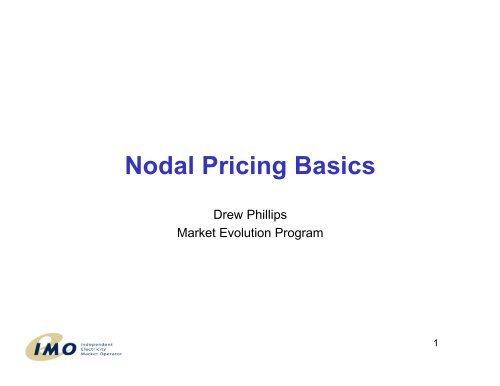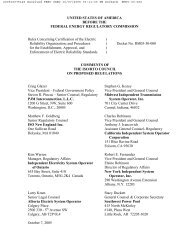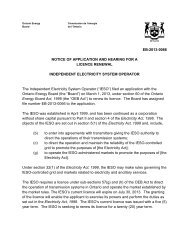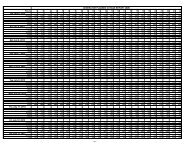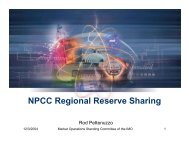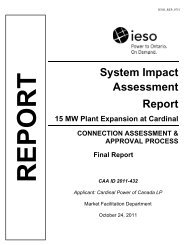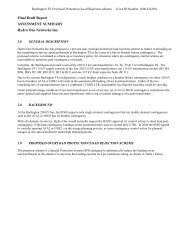Nodal Pricing Basics - IESO
Nodal Pricing Basics - IESO
Nodal Pricing Basics - IESO
Create successful ePaper yourself
Turn your PDF publications into a flip-book with our unique Google optimized e-Paper software.
<strong>Nodal</strong> <strong>Pricing</strong> <strong>Basics</strong><br />
Drew Phillips<br />
Market Evolution Program<br />
1
Agenda<br />
• What is <strong>Nodal</strong> <strong>Pricing</strong><br />
• Impedance, Power Flows Losses and Limits<br />
• <strong>Nodal</strong> Price Examples<br />
• No Losses or Congestion<br />
• Congestion Only<br />
– Impact of Transmission Rights<br />
• Losses Only<br />
• How DSO Calculates <strong>Nodal</strong> Prices<br />
2
What is <strong>Nodal</strong> <strong>Pricing</strong><br />
• <strong>Nodal</strong> <strong>Pricing</strong><br />
= Locational Marginal <strong>Pricing</strong> (LMP)<br />
= Locational Based Marginal <strong>Pricing</strong> (LBMP)<br />
• <strong>Nodal</strong> <strong>Pricing</strong> is a method of determining prices in which market clearing<br />
prices are calculated for a number of locations on the transmission grid<br />
called nodes<br />
• Each node represents the physical location on the transmission<br />
system where energy is injected by generators or withdrawn by loads<br />
• Price at each node represents the locational value of energy, which<br />
includes the cost of the energy and the cost of delivering it, i.e., losses<br />
and congestion<br />
• IMO publishes nodal prices for information purposes; they are referred<br />
to as shadow prices<br />
3
What causes locational differences<br />
Losses<br />
• Due to the physical characteristics of the transmission system,<br />
energy is lost as it is transmitted from generators to loads<br />
• Additional generation must be dispatched to provide energy in<br />
excess of that consumed by load<br />
Transmission congestion<br />
• Prevents lower cost generation from meeting the load; higher<br />
cost generation must be dispatched in its place<br />
In both cases, the associated costs are allocated to each node in a<br />
manner that recognizes their individual contribution to/impact on<br />
these extra costs<br />
4
Impedance, Power Flows, Losses and Limits<br />
5
Impedance and its effect on power flows<br />
Impedance<br />
• Is a characteristic of all transmission system elements<br />
• Signifies opposition to power flow<br />
• A higher impedance path indicates more opposition to power flow and<br />
greater losses<br />
Impedance between two points on the grid is related to:<br />
• Line length<br />
• Number of parallel paths<br />
• Voltage level<br />
• Number of series elements such as transformers<br />
Impedance will be lower where there are:<br />
• Shorter transmission lines<br />
• More parallel paths<br />
• Higher voltage<br />
• Fewer series transformers<br />
6
Relative Impedance and Power Flow<br />
Gen<br />
Load<br />
Transformer<br />
230 kV<br />
115 kV<br />
Energy will flow preferentially on the 230 kV path:<br />
• Higher voltage<br />
• More lines in parallel<br />
• Fewer transformers<br />
7
Power Flows<br />
• Power will take all available paths to get from supply<br />
point to consumption point<br />
• Power flow distribution on a transmission system is a<br />
function of:<br />
• Location and magnitude of generation<br />
• Location and magnitude of load<br />
• Relative impedance of the various paths between generation<br />
and load<br />
• The following examples ignore the effect of losses<br />
8
Power Flows<br />
N Load<br />
75 %<br />
N<br />
W Gen<br />
W<br />
E<br />
E Gen<br />
S<br />
25 %<br />
• All lines have equal impedance<br />
• Path W-S-E-N has three times the impedance of path W-N<br />
• Flow divides inversely to impedance<br />
• If W Gen supplies N Load, flow W-S-E-N is one third flow W-N<br />
• If N Load is 100 MW, 75 MW flows on path W-N, 25 MW flows on<br />
path W-S-E-N<br />
9
What if E Gen supplies N Load<br />
N Load<br />
N<br />
75 %<br />
W<br />
25 %<br />
E<br />
E Gen<br />
S<br />
• Path E-S-W-N has three times the impedance of path W-N<br />
• Flow divides inversely to impedance<br />
• If E Gen supplies N Load, flow E-S-W-N is one third flow E-N<br />
• If N Load is 100 MW, 75 MW flows on path E-N, 25 MW flows on<br />
path E-S-W-N<br />
10
Superposition<br />
N Load 100 MW<br />
N<br />
(45 + 10) 55 45 MW 45 MW (15 + 30)<br />
30 MW<br />
60 MW<br />
W Gen<br />
W<br />
10 MW<br />
E<br />
E Gen<br />
40 MW<br />
(15 – 10) 5 MW<br />
5 MW 15 MW (15 – 10)<br />
S<br />
• What if W Gen supplies 60 MW and E Gen supplies<br />
40 MW to N Load<br />
• Both W Gen and E Gen’s output will flow in proportion<br />
to the impedance of the paths to N Load<br />
• Resulting line flows represent the net impact of their<br />
flow distribution<br />
11
Loss Comparison for 100 km Lines<br />
90 MW<br />
180 A<br />
89.9 MW<br />
500 kV<br />
90 MW<br />
390 A<br />
88.5 MW<br />
A<br />
230 kV<br />
90 MW 780 A<br />
115 kV<br />
79.5 MW<br />
Current (Amps)<br />
• Losses are:<br />
• proportional to Current 2 x Resistance (I 2 R)<br />
• lower on higher voltage lines because resistance<br />
is lower and current flow is lower for a given MW<br />
flow<br />
12
Loss Comparison<br />
Losses (M W)<br />
Current (I)<br />
• Losses are higher on a line that is heavily loaded for the same increase<br />
in current<br />
=<br />
13
Security Limits<br />
• Security limits are the reliability envelope in which the<br />
market operates<br />
• Power will take all available paths to get from supply<br />
point to consumption point<br />
• Transmission lines do not control or limit the amount<br />
of power they convey<br />
• Power flows are managed by dispatching the system<br />
(normally via dispatch instructions and interchange<br />
scheduling)<br />
• Must respect current conditions and recognized<br />
contingencies<br />
14
<strong>Nodal</strong> Price Examples<br />
15
How are nodal prices derived<br />
• Marginal cost is the cost of the next MW; the marginal generator is the<br />
generator that would be dispatched to serve the next MW<br />
• This is the basis of our current unconstrained market clearing price<br />
• A nodal price is the cost of serving the next MW of load at a given<br />
location (node)<br />
• <strong>Nodal</strong> prices are formulated using a security constrained dispatch and<br />
the costs of supply are based upon participant offers and bids<br />
• <strong>Nodal</strong> prices consist of three components:<br />
<strong>Nodal</strong><br />
Price<br />
Marginal<br />
Cost of<br />
Generation<br />
Marginal<br />
Cost of<br />
Losses<br />
= + +<br />
Marginal<br />
Cost of<br />
Transmission<br />
Congestion<br />
16
Current <strong>Pricing</strong> Scheme<br />
$<br />
Uniform<br />
Price<br />
Market<br />
Participants<br />
Bids/<br />
Offers<br />
IMO<br />
Bids/<br />
Offers<br />
Unconstrained<br />
Calculation<br />
• ignores physical<br />
limitations<br />
Constrained<br />
Calculation<br />
• considers physical<br />
limitations<br />
Market<br />
Schedule<br />
Dispatch<br />
Schedule<br />
CMSC<br />
Dispatchable<br />
resources<br />
produce or<br />
consume MWs<br />
<strong>Nodal</strong><br />
Prices<br />
Currently calculated for information purposes only<br />
17
<strong>Nodal</strong> Price Calculations<br />
• No Congestion or Losses<br />
• With Congestion<br />
• With Losses<br />
Process:<br />
• Determine least cost dispatch to serve load<br />
• Determine resulting power flows to ensure security limits are<br />
respected<br />
• Calculate prices by determining the dispatch for one additional<br />
MW at each node (while still respecting all limits)<br />
18
No Congestion or Losses<br />
19
No Congestion or Losses: Dispatch<br />
Transmission Limit = 85 MW<br />
N Load<br />
N<br />
100 MW<br />
75 MW 25 MW<br />
Offer<br />
125 @ $30<br />
W Gen<br />
W<br />
E<br />
E Gen<br />
Offer<br />
125 @ $35<br />
Dispatch<br />
100 MW<br />
25 MW<br />
S<br />
25 MW<br />
Dispatch<br />
0 MW<br />
• Least cost solution would have W Gen supply all 100 MW to N<br />
Load, based on W Gen’s offer price<br />
• Resultant flow is within limits<br />
• <strong>Nodal</strong> price is the cost of serving the next MW<br />
• What are the prices at each node<br />
20
Offer<br />
No Congestion or Losses: Node N Price<br />
125 @ $30<br />
Transmission Limit = 85 MW<br />
N Load 100 MW + 1 MW<br />
N<br />
(75 + .75) 75.75 MW<br />
$30<br />
25.25 MW (25 + .25)<br />
W Gen<br />
Dispatch<br />
100 MW<br />
+1 MW<br />
W<br />
25.25 MW<br />
25.25 MW<br />
(25 + .25)<br />
S<br />
(25 + .25)<br />
E<br />
Offer<br />
E Gen 125 @ $35<br />
Dispatch<br />
0 MW<br />
• Price at Node N is the cost of supplying next 1 MW to N<br />
• Least cost solution would have W Gen supply the next MW to N, based<br />
on W Gen’s offer price<br />
• Resultant flow would be within limits (net of existing flow and increment<br />
to serve additional 1 MW at Node N)<br />
• W Gen is the marginal generator and Node N price = $30<br />
21
No Congestion or Losses: Node W Price<br />
Transmission Limit = 85 MW<br />
N Load<br />
N<br />
100 MW<br />
75 MW 25 MW<br />
Offer<br />
125 @ $30<br />
+ 1 MW<br />
W Gen W $30<br />
E<br />
E Gen<br />
Offer<br />
125 @ $35<br />
Dispatch<br />
Dispatch<br />
100 MW<br />
+1 MW<br />
25 MW<br />
S<br />
25 MW<br />
0 MW<br />
• Price at Node W is the cost of supplying next 1 MW at W<br />
• Least cost solution would have W Gen supply the next MW to W,<br />
based on W Gen’s offer price<br />
• Resultant flow would be within limits (net flow change is zero)<br />
• W Gen is the marginal generator and Node W price = $30<br />
22
No Congestion or Losses: Node E Price<br />
Transmission Limit = 85 MW<br />
N Load<br />
N<br />
100 MW<br />
(75 + .5)<br />
75.5 MW 24.5 MW<br />
(25 - .5)<br />
Offer<br />
125 @ $30<br />
W Gen<br />
W<br />
+ 1 MW<br />
$30 E<br />
E Gen<br />
Offer<br />
125 @ $35<br />
Dispatch<br />
100 MW<br />
+1 MW<br />
25.5 MW<br />
25.5 MW<br />
(25 + .5)<br />
S<br />
(25 + .5)<br />
Dispatch<br />
0 MW<br />
• Price at Node E is the cost of supplying next 1 MW to E<br />
• Least cost solution would have W Gen supply the next MW to N, based<br />
on W Gen’s offer price<br />
• Resultant flow would be within limits (net of existing flow and increment<br />
to serve additional 1 MW at Node E)<br />
• W Gen is the marginal generator and Node E price = $30<br />
23
No Congestion or Losses: Node S Price<br />
Transmission Limit = 85 MW<br />
N Load<br />
N<br />
100 MW<br />
(75 + .25)<br />
75.25 MW 24.75 MW<br />
(25 - .25)<br />
Offer<br />
125 @ $30<br />
W Gen<br />
W<br />
E<br />
E Gen<br />
Offer<br />
125 @ $35<br />
Dispatch<br />
100 MW<br />
+1 MW<br />
25.75 MW $30 24.75 MW<br />
(25 + .75)<br />
S<br />
(25 - .25)<br />
+ 1 MW<br />
Dispatch<br />
0 MW<br />
• Price at Node S is the cost of supplying next 1 MW at S<br />
• Least cost solution would have W Gen supply the next MW to S, based<br />
on W Gen’s offer price<br />
• Resultant flow would be within limits (net of existing flow and increment<br />
to serve additional 1 MW at Node S)<br />
• W Gen is the marginal generator and Node S price = $30<br />
24
Summary<br />
• The previous examples demonstrate the method used to derive nodal<br />
prices<br />
• As we would expect, the nodal prices at all nodes on a transmission<br />
system will be the same in the absence of losses and congestion<br />
• Unfortunately, no such transmission system exists<br />
• The following examples will apply the same method to illustrate the<br />
calculation under conditions of congestion and then losses<br />
• Examples:<br />
• are not representative of how the IMO-controlled grid is dispatched<br />
and therefore the impact on nodal prices is entirely fictitious; these<br />
scenarios were designed to illustrate a concept while keeping the<br />
calculation as simple as possible<br />
• are for illustrative purposes only and do not imply a settlement basis<br />
for a nodal pricing methodology for Ontario<br />
25
Congestion, No Losses<br />
26
Congestion (No Losses): Dispatch<br />
Transmission Limit = 75.2 MW<br />
N Load<br />
N<br />
100 MW<br />
75 MW 25 MW<br />
Offer<br />
125 @ $30<br />
W Gen<br />
W<br />
E<br />
E Gen<br />
Offer<br />
125 @ $35<br />
Dispatch<br />
100 MW<br />
25 MW<br />
S<br />
25 MW<br />
Dispatch<br />
0 MW<br />
• Assume the transmission limit is reduced; dispatch can be solved<br />
as in the no congestion case, but what is the effect on nodal<br />
prices<br />
27
Congestion (No Losses): Node N Price<br />
Transmission Limit = 75.2 MW<br />
N Load 100 MW + 1 MW<br />
N<br />
75.2 MW<br />
$35.50<br />
25.8 MW<br />
Offer<br />
125 @ $30 W Gen W<br />
E<br />
Dispatch<br />
100 MW 24.7 MW<br />
24.7 MW<br />
-.1 MW<br />
S<br />
E Gen 125 @ $35<br />
Dispatch<br />
0 MW<br />
+1.1 MW<br />
Offer<br />
• An increase in output of 1 MW by either W Gen or E Gen alone will<br />
increase the W-N line flow over the limit; we must redispatch the system<br />
using both generators<br />
• If we reduce W Gen output by 0.1 MW (75% of the reduction will appear<br />
on W to N flow) and increase E Gen output by 1.1 MW (25% flows from<br />
N to W), net effect is on line W-N is a flow increase of .2 MW<br />
• This is the lowest cost way to meet an additional 1 MW at N<br />
• Node N price = $35.50 (1.1 X $35 – 0.1 X $30)<br />
28
Congestion (No Losses): Node E Price<br />
Transmission Limit = 75.2 MW<br />
N Load<br />
N<br />
100 MW<br />
Offer<br />
125 @ $30<br />
W Gen<br />
Dispatch<br />
100 MW<br />
+.4 MW<br />
W<br />
75.2 MW 24.8 MW<br />
25.2 MW<br />
S<br />
$33<br />
25.2 MW<br />
+ 1 MW<br />
E<br />
E Gen 125 @ $35<br />
Dispatch<br />
0 MW<br />
+.6 MW<br />
Offer<br />
• An increase in output of 1 MW by either W Gen or E Gen alone will<br />
increase the W-N line flow over the limit; we must redispatch the system<br />
using both generators<br />
• If we increase W Gen output by 0.4 MW (50% flows from W to N) and<br />
increase E Gen output by .6 MW (0% flows from N to W), net effect is<br />
on line W-N is a flow increase of .2 MW<br />
• This is the lowest cost way to meet an additional 1 MW at E<br />
• Node E price = $33 (0.6 X $35 + 0.4 X $30)<br />
29
Congestion (No Losses): Node S Price<br />
Transmission Limit = 75.2 MW<br />
N Load<br />
N<br />
100 MW<br />
75.2 MW 24.8 MW<br />
Offer<br />
125 @ $30<br />
W Gen<br />
W<br />
E<br />
Offer<br />
E Gen 125 @ $35<br />
Dispatch<br />
100 MW<br />
+.9 MW<br />
25.7 MW $30.50<br />
S<br />
+ 1 MW<br />
24.7 MW<br />
Dispatch<br />
0 MW<br />
+.1 MW<br />
• An increase in output of 1 MW by either W Gen or E Gen alone will<br />
increase the W-N line flow over the limit; we must redispatch the system<br />
using both generators<br />
• If we increase W Gen output by 0.8 MW (25% flows from W to N) and<br />
increase E Gen output by .2 MW (25% flows from N to W), net effect is<br />
on line W-N is a flow increase of .2 MW<br />
• This is the lowest cost way to meet an additional 1 MW at E<br />
• Node S price = $30.50 (0.1 X $35 + 0.9 X $30)<br />
30
Congestion (No Losses): Node W Price<br />
Transmission Limit = 75.2 MW<br />
N Load<br />
N<br />
100 MW<br />
75 MW 25 MW<br />
Offer<br />
125 @ $30<br />
+ 1 MW<br />
W Gen W $30<br />
E<br />
E Gen<br />
Offer<br />
125 @ $35<br />
Dispatch<br />
Dispatch<br />
100 MW<br />
+1 MW<br />
25 MW<br />
S<br />
25 MW<br />
0 MW<br />
• Least cost solution would have W Gen supply the next MW to W,<br />
based on W Gen’s offer price<br />
• W Gen can meet the additional MW at Node W without affecting<br />
the transmission system (net flow change is zero)<br />
• W Gen is the marginal generator and Node W price = $30<br />
31
Congestion (No Losses): Summary<br />
Transmission Limit = 75.2 MW<br />
N Load 100 MW<br />
N<br />
75 MW<br />
$35.50<br />
25 MW<br />
Offer<br />
125 @ $30<br />
W Gen<br />
W<br />
$30<br />
$33<br />
E<br />
E Gen<br />
Offer<br />
125 @ $35<br />
Dispatch<br />
100 MW<br />
25 MW<br />
$30.50<br />
S<br />
25 MW<br />
Dispatch<br />
0 MW<br />
• System is congested on line W-N<br />
• Combination of W Gen and E Gen redispatch is necessary to meet<br />
incremental loads at Node N,E and S<br />
• If W Gen and N Load are settled at their respective nodal prices, the<br />
difference will result in a settlement surplus<br />
• Surplus due to the congestion component of different nodal prices is<br />
used to fund transmission rights<br />
32
Transmission Rights<br />
• Provide a hedge against congestion charges between two locations<br />
• Transmission rights holders receive the difference in congestion charges<br />
between the two locations defined by the transmission right<br />
• Using our example:<br />
• Price at N - Price at W = Congestion Charge<br />
• $35.5 - $30 = $5.50/MW<br />
• If N load holds 100 MW of transmission rights, they will receive<br />
100 x $5.50 = $550<br />
• N Load:<br />
• Pays 100 x $35.50 = $3550 for energy<br />
• Receives 100 x $5.50 = $550 for transmission rights<br />
• Net = $3000<br />
• W Gen is paid 100 x $30 = $3000<br />
33
Exercise One<br />
N Load<br />
N<br />
100 MW<br />
75 MW 25 MW<br />
Offer<br />
125 @ $30<br />
W Gen<br />
W<br />
E<br />
E Gen<br />
Offer<br />
125 @ $35<br />
Dispatch<br />
100 MW<br />
25 MW<br />
S<br />
25 MW<br />
Dispatch<br />
0 MW<br />
Transmission Limit = 25 MW<br />
• Assume the transmission limit is on line S-E (for simplicity we’ll allow<br />
flow to equal the limit, although in reality flow must be less than the limit)<br />
• The load at N is being served by W Gen with flows on the transmission<br />
system as shown<br />
• What are the nodal prices at N and S<br />
34
Exercise Answer: Node N Price<br />
(75 +.375 + .125)<br />
N Load 100 MW + 1 MW<br />
N<br />
75.5 MW $32.50 25.5 MW (25 +.125 + .375)<br />
Offer<br />
125 @ $30<br />
W Gen<br />
W<br />
E<br />
Offer<br />
E Gen 125 @ $35<br />
Dispatch<br />
100 MW<br />
+.5 MW<br />
25 MW<br />
25 MW<br />
(25 +.125 – .125)<br />
S (25 +.125 – .125)<br />
Transmission Limit = 25 MW<br />
Dispatch<br />
0 MW<br />
+.5 MW<br />
• W Gen cannot be used as sole supply as any increase in output will<br />
increase the S-E line flow; must redispatch the system<br />
• Must increase W Gen output by 0.5 MW (25% flows from S to E) and<br />
increase E Gen output by 0.5 MW (25% flows from E to S)<br />
• Resultant flow would be within limits<br />
• Node N price = $32.50 (0.5 X $35 + 0.5 X $30)<br />
35
Exercise Answer: Node S Price<br />
(75 + .75)<br />
N Load 100 MW<br />
N<br />
75.25 MW 24.75 MW<br />
(25 - .25)<br />
Offer<br />
125 @ $30<br />
W Gen<br />
W<br />
E<br />
Offer<br />
E Gen 125 @ $35<br />
Dispatch<br />
100 MW<br />
+1 MW<br />
25.75 MW $30 24.75 MW<br />
(25 + .75)<br />
S (25 - .25)<br />
+ 1 MW<br />
Dispatch<br />
0 MW<br />
Transmission Limit = 25 MW<br />
• W Gen can be used as sole supply; the increase in output to<br />
serve Node S will decrease the S-E line flow<br />
• Increase W Gen output by 1.0 (75% flows from E to S)<br />
• Resultant flow would be within limits<br />
• Node S price = $30<br />
36
Losses, No Congestion<br />
37
Losses (No Congestion): Dispatch<br />
75 MW<br />
N Load<br />
N<br />
100 MW<br />
25 MW<br />
Offer<br />
125 @ $30<br />
W Gen W<br />
Dispatch<br />
78 MW<br />
26 MW<br />
E<br />
E Gen<br />
Dispatch<br />
Offer<br />
125 @ $35<br />
104 MW<br />
S<br />
0 MW<br />
• Least cost solution would have W Gen supply all 100 MW to N<br />
Load due to its lower offer price, but due to losses must generate<br />
104 MW<br />
• Resultant flow is within limits<br />
• <strong>Nodal</strong> price is the cost of serving the next MW<br />
• What are the prices at Node N<br />
38
Losses (No Congestion): Node N Price<br />
75.75 MW<br />
N Load<br />
N<br />
$31.20<br />
100 MW<br />
25.25 MW<br />
+ 1 MW<br />
Offer<br />
125 @ $30<br />
W Gen<br />
Dispatch<br />
104 MW<br />
+1.04 MW<br />
78.9 MW<br />
W<br />
26.3 MW<br />
• Price at node N is the cost of supplying next 1 MW<br />
• W Gen must generate an additional 1.04 MW to N to deliver 1 MW at<br />
Node N<br />
• Resultant flow would be within limits<br />
• Node N price = $31.20 (1.04 X $30)<br />
• Prices at Nodes E and S would be similarly calculated<br />
• Price at Node W = $30 as an increment of load can be supplied from W<br />
Gen with no impact to transmission flows<br />
S<br />
E<br />
E Gen<br />
Dispatch<br />
0 MW<br />
Offer<br />
125 @ $35<br />
39
Summary<br />
• When more than one generator is on the margin, prices may be:<br />
• higher than any offer<br />
• lower than any offer (and could even be negative)<br />
For additional examples see the Market Evolution Day Ahead Market web page<br />
and in particular:<br />
http://www.theimo.com/imoweb.pubs/consult/mep/dam_wg_2003sep16_LMPexamples.pdf<br />
• Even when there is no congestion on the transmission system directly<br />
connecting them, prices may be different between two nodes due to:<br />
• losses and/or<br />
• their differing impact on congested paths elsewhere in the system<br />
• If a generator is partially dispatched: nodal price = offer price<br />
• If a generator is fully dispatched: nodal price > than offer price<br />
• If a generator is not dispatched: nodal price < than offer price<br />
40
How the Dispatch Scheduling Algorithm (DSO)<br />
Calculates <strong>Nodal</strong> Prices<br />
41
Dispatch Scheduling Optimizer (DSO)<br />
• Two methods are available to calculate nodal prices:<br />
1) calculate nodal prices at each node directly (as in previous<br />
examples)<br />
2) calculate a reference node price then derive prices at all other<br />
nodes<br />
• The DSO uses method 2 as it requires less computing power and<br />
is faster:<br />
• It yields the same results as method 1<br />
• It does not matter which node is chosen as the reference bus<br />
42
Calculate <strong>Nodal</strong> Prices<br />
<strong>Nodal</strong><br />
Price<br />
Cost of losses incurred for the<br />
next MW of load at the node<br />
LMP<br />
Marginal<br />
Cost of s<br />
Generation<br />
(DF n - 1)* s<br />
Marginal Cost of<br />
Losses<br />
n = + +<br />
Marginal Cost<br />
of<br />
Transmission<br />
S a nk* µ k<br />
Congestion<br />
System Marginal Cost at<br />
Reference Node<br />
Cost of transmission limits<br />
incurred for the next MW of<br />
load at the node<br />
43
Inputs<br />
• Offers and bids<br />
• Forecast demand for the next interval based upon a snapshot of<br />
current demand modified by the expected +/- in the next interval<br />
• Load profile based upon the current system snapshot<br />
• Physical model of the transmission system<br />
• Security limits<br />
• Penalty Factors (losses)<br />
• represent losses between nodes and the reference bus<br />
• IMO uses fixed losses for each node based on historical<br />
power flows<br />
44
Penalty Factors<br />
PF = 1.3<br />
= 23% losses<br />
Gen D<br />
Load Z Non-dispatchable<br />
PF = .97<br />
= - 3.1% losses<br />
Richview<br />
Gen C<br />
PF = .95<br />
= - 5.3% losses<br />
Gen B<br />
PF = 1.01<br />
= 1% losses<br />
Gen A<br />
PF = .9<br />
= - 11.2% losses<br />
• Represent incremental impact on losses for generation or load at<br />
each node based on a representative power flow distribution on<br />
the grid<br />
• If PF > 1: losses are incurred for each MW delivered to Richview<br />
• If PF < 1: losses are reduced for each MW delivered to Richview<br />
45
<strong>Nodal</strong> Price Calculation in DSO<br />
• Penalty Factors<br />
• Bids and Offers<br />
• Forecast Load<br />
• System Limits<br />
• Transmission Model<br />
• Load Profile<br />
• Penalty Factors<br />
• Richview <strong>Nodal</strong> Price<br />
• Congestion Impact<br />
DSO Calculation 1<br />
DSO Calculation 2<br />
• Richview <strong>Nodal</strong> Price<br />
• Congestion Impact<br />
• Dispatch Instructions<br />
• All Other <strong>Nodal</strong> Prices<br />
46
Reference Bus Merit Order<br />
Delivery Point<br />
Offer/Bid Stack<br />
Gen A 100 MW @ $75<br />
Gen B 100 MW @ $70<br />
Gen C 100 MW @ $60<br />
Gen D 100 MW @ $50<br />
Penalty<br />
Factors<br />
.90<br />
1.01<br />
.95<br />
1.3<br />
Richview Equivalent<br />
Offer/Bid Stack<br />
Gen B 100 MW @ $70.7<br />
Gen A 100 MW @ $67.5<br />
Gen D 100 MW @ $65<br />
Gen C 100 MW @ $57<br />
Subsequent calculation addresses quantity differences due to the<br />
effect of losses<br />
47
Effective Price<br />
Delivery Point<br />
Offer/Bid Stack<br />
Penalty<br />
Factors<br />
Richview Equivalent<br />
Offer/Bid Stack<br />
Gen D 100 MW @ $50 1.3<br />
Gen D 100 MW @ $65<br />
If we generate 100 MW at Gen D, only 100/1.3 or 76.9 MW<br />
shows up at Richview due to losses<br />
100 MW at Gen D costs 100 x $50 = $5,000, which only<br />
yields 76.9 MW at Richview, resulting in an effective price of<br />
$5000/76.9 MW = $65 /MW<br />
48
Determine Unconstrained Economic Solution<br />
Richview Equivalent<br />
Offer/Bid Stack<br />
Current system demand +/-<br />
forecast change in next interval<br />
Gen B 100 MW @ $70.7<br />
Gen A 100 MW @ $67.5<br />
Gen D 100 MW @ $65<br />
Gen C 100 MW @ $57<br />
Forecast<br />
Demand<br />
49
Introduce Physical Network<br />
Load Z<br />
Gen D<br />
4%<br />
4%<br />
3%<br />
1%<br />
Richview<br />
5%<br />
3%<br />
2%<br />
Gen C<br />
4%<br />
5%<br />
Gen B<br />
6%<br />
10%<br />
2%<br />
Gen A<br />
• Allocate forecast demand to nodes based on load profile of<br />
current system<br />
• Run load flow to solve power balance using offers and bids at<br />
appropriate nodes, physical characteristics of transmission<br />
system and system limits<br />
• Determine System Marginal Cost at Richview<br />
50
System Marginal Cost: No Congestion<br />
Gen B 100 MW @ $70.7<br />
Gen A 100 MW @ $67.5<br />
Gen D 100 MW @ $65<br />
Gen C 100 MW @ $57<br />
Forecast<br />
Demand<br />
• If power balance is solved without any need to redispatch to<br />
respect limits; there is no congestion and the system marginal<br />
cost will equal that determined in the purely economic merit order<br />
i.e., Gen D will set the system marginal cost<br />
• System Marginal Cost ( s ) = $65<br />
51
<strong>Nodal</strong> Prices: No Congestion<br />
Offer<br />
Price<br />
Penalty<br />
Factor<br />
Losses<br />
Cost<br />
Congestion<br />
Cost<br />
<strong>Nodal</strong><br />
Price<br />
Gen A<br />
$75<br />
0.90<br />
$7.22<br />
0<br />
$72.22<br />
Gen B<br />
$70<br />
1.01<br />
-$0.64<br />
0<br />
$64.36<br />
Gen C<br />
$60<br />
0.95<br />
$3.42<br />
0<br />
$68.42<br />
Gen D $50 1.30 -$15.00 0 $50.00<br />
Load Z N/A 0.97 $2.01 0 $67.01<br />
Richview = s<br />
$65.00<br />
52
<strong>Nodal</strong> Prices and Dispatch: No Congestion<br />
$50.00<br />
Gen D<br />
Partially dispatched<br />
$65.00<br />
Richview<br />
$68.42<br />
Gen C<br />
Fully dispatched<br />
Gen B<br />
$64.36<br />
Gen A<br />
$72.22<br />
Offer prices:<br />
• Gen A $75<br />
• Gen B $70<br />
• Gen C $60<br />
• Gen D $50<br />
Which generators should be dispatched<br />
53
Congestion<br />
Binding Transmission Limit<br />
Load Z<br />
Gen D<br />
Line 1<br />
Richview<br />
Gen C<br />
Gen B<br />
Gen A<br />
• If a transmission limit on the line from Gen D prevents its<br />
economic dispatch another more expensive resource must be<br />
dispatched to meet demand<br />
• This congestion will raise the system marginal cost and affect<br />
nodal prices throughout the system<br />
54
System Marginal Cost: Congestion<br />
Gen B 100 MW @ $70.7<br />
Gen A 100 MW @ $67.5<br />
Gen D 90 MW @ $65<br />
Gen C 100 MW @ $57<br />
Forecast<br />
Demand<br />
• Congestion on Line 1 from Gen D: redispatch from<br />
economic merit order to respect limit<br />
• System marginal cost is now set by Gen A<br />
• System Marginal Cost ( s ) = $67.5<br />
• There is a cost associated with the Line 1 transmission<br />
limit<br />
55
Line 1 Transmission Limit Cost<br />
Binding Transmission Limit<br />
Load Z<br />
Gen D<br />
Line 1<br />
Richview<br />
Gen C<br />
Gen B<br />
Gen A<br />
• Determine transmission limit cost by relaxing constraint by 1 MW<br />
and measuring impact on total system costs<br />
• Note: results are rounded on the following diagrams<br />
56
Line 1 Transmission Limit Cost<br />
Load Z<br />
+1 MW 23% losses<br />
Gen D<br />
Gen C<br />
Gen B<br />
Richview<br />
+.77 MW<br />
- 11.2% losses<br />
Gen A<br />
-.69 MW<br />
• Increase Gen D by 1 MW results in +.7692 MW at Richview due<br />
to losses<br />
• To maintain the generation/load balance we must reduce Gen A<br />
by .6923 MW<br />
• Net cost is $50 x 1 MW - $75 x .6923 MW = -$1.92<br />
57
<strong>Nodal</strong> Prices: Congestion<br />
Offer<br />
Price<br />
Penalty<br />
Factor<br />
Losses<br />
Cost<br />
Congestion<br />
Cost<br />
<strong>Nodal</strong><br />
Price<br />
Gen A<br />
$75<br />
0.90<br />
$7.50<br />
0<br />
$75.00<br />
Gen B<br />
$70<br />
1.01<br />
-$0.67<br />
0<br />
$66.83<br />
Gen C<br />
$60<br />
0.95<br />
$3.55<br />
0<br />
$71.05<br />
Gen D<br />
$50<br />
1.30<br />
-$15.58<br />
-1.92<br />
$50.00<br />
Load Z N/A 0.97 $2.09 0 $69.59<br />
Richview = s<br />
$67.50<br />
58
<strong>Nodal</strong> Prices and Dispatch: Congestion<br />
Binding Transmission Limit<br />
$50.00<br />
Gen D<br />
Partially dispatched<br />
Line 1<br />
$67.50<br />
Richview<br />
$71.05<br />
Gen C<br />
Fully dispatched<br />
Gen B<br />
$66.83<br />
Gen A<br />
$75.00<br />
Partially dispatched<br />
Offer prices:<br />
• Gen A $75<br />
• Gen B $70<br />
• Gen C $60<br />
• Gen D $50<br />
Which generators should be dispatched<br />
59
<strong>Nodal</strong> Price Comparison<br />
Gen A<br />
Gen B<br />
Gen C<br />
Gen D<br />
<strong>Nodal</strong> Price<br />
(No Congestion)<br />
$72.22<br />
$64.36<br />
$68.42<br />
$50.00<br />
<strong>Nodal</strong> Price<br />
(Congestion)<br />
$75.00<br />
$66.83<br />
$71.05<br />
$50.00<br />
Load Z $67.01 $69.59<br />
Richview = s<br />
$65.00 $67.50<br />
60
Getting <strong>Nodal</strong> Price Information<br />
• <strong>Nodal</strong> prices available on IMO FTP site only (in .csv format)<br />
• Go to Market Data page:<br />
• http://www.theimo.com/imoweb/marketdata/marketData.asp<br />
• Scroll down to hyperlink:<br />
• ftp://aftp.theimo.com/pub/reports/PUB/<br />
• Select DispConsShadowPrice folder<br />
• Choose report date and hour i.e., Sept 20 for Hour 1:<br />
• PUB_DispConsShadowPrice_2003092001.csv<br />
1 6 RICHVIEW-230.G_SLACKA 36.13 1.12 0.77 0.77 DSO-RD;<br />
Hour Interval<br />
Node<br />
Energy<br />
Operating Reserve<br />
10S/10NS/30<br />
61


